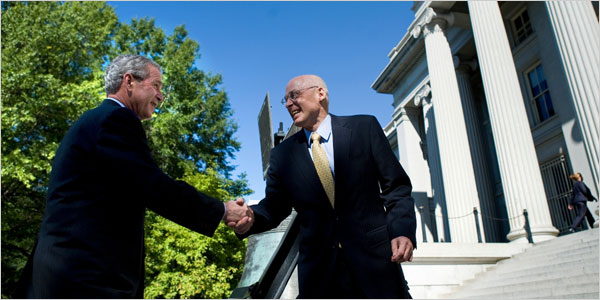It would raise the statutory limit on the national debt from $10.6 trillion to $11.3 trillion to make room for the massive rescue. The proposal does not specify what the government would get in return from financial companies for the federal assistance.
Source: "Obama: Economic fix should also help Main Street" By THE ASSOCIATED PRESS - NY Times - September 20, 2008
Last week ABC News asked 16 of the banks that have received handouts from the Treasury Department’s $700 billion Troubled Asset Relief Program the same two direct questions: How have you used that money, and how much have you spent on bonuses this year? Most refused to answer.
Congress can’t get the answers either. Its oversight panel declared in a first report this month that the Treasury is doling out billions “without seeking to monitor the use of funds provided to specific financial institutions.” The Treasury prefers instead to look at “general metrics” indicating the program’s overall effect on the economy. Well, we know what the “general metrics” tell us already: the effect so far is nil. Perhaps if we were let in on the specifics, we’d start to understand why.
In its own independent attempt to penetrate the bailout, the Government Accountability Office learned that “the standard agreement between Treasury and the participating institutions does not require that these institutions track or report how they plan to use, or do use, their capital investments.” Executives at all but two of the bailed-out banks told the G.A.O. that the “money is fungible,” so they “did not intend to track or report” specifically what happens to the taxpayers’ cash.
Nor is there any serious accounting for executive pay at these seminationalized companies. As Amit Paley of The Washington Post reported, a last-minute, one-sentence loophole added by the Bush administration to the original bailout bill gutted the already minimal restrictions on executive compensation. And so when Goldman Sachs, Henry Paulson’s Wall Street alma mater, says that it is not using public money to pay executives, we must take it on faith.
Source: "Who Wants to Kick a Millionaire?" By FRANK RICH - NY Times - December 20, 2008
Now that the government has awarded $700 billion to buy up "junk loans" from Wall Street, somebody has to decide who gets what.
Treasury officials do not plan to manage the mortgage assets on their own. Instead, they will outsource nearly all of the work to professionals, who will oversee huge portfolios of bonds and other securities for a management fee.
The selected asset management firms will receive a chunk of the $250 billion that Congress is allowing the Treasury to spend in the first phase of the bailout. Those firms will receive fees that are likely to be lower than the industry standard of 1 percent of assets, or $1 for every $100 under management.
Many of the junk loans and mortgage-backed securities have no market price at all because they have no potential buyers. The firms hired by the government will have enormous power to push the “market” price up or down as they choose.
Source: "For Treasury Dept., Now Comes Hard Part of Bailout" By MARK LANDLER and EDMUND L. ANDREWS - NY Times - October 3, 2008
Think about that. The contractor earns a fee based on the percentage of the asset value. AND HE SETS THE VALUE. In other words, the more the contractor arranges for us (the taxpayers) to pay for "junk loans," the larger his commission. But wait…there's more...
Inevitably, large asset management firms own, or are tied to banks that own, some of the same securities the government is seeking to sell. Pimco, for example, is owned by Allianz, one of Germany’s largest insurance companies. Merrill Lynch owns a stake in BlackRock.
“I can’t even fathom how I would manage that,” [Joshua S. Siegel, the managing principal of Stone Capital Partners, a fund that manages $2.2 billion] said. “How would I manage one side, where I’m seeking to maximize profit, and the other side, where I’m looking out for the social good?”
Source: "For Treasury Dept., Now Comes Hard Part of Bailout" By MARK LANDLER and EDMUND L. ANDREWS - NY Times - October 3, 2008
That's a good question Mr. Siegel. Anyone care to venture a prediction? Let's see…if I'm tasked to decide what the government will pay for a "junk loan" that is owned by a subsidiary of my company…hmmmm…
Interim guidelines released last week require applicants to disclose ''any actual or potential conflicts of interest'' that may come into play. Applicants must submit a plan to show how they will ''avoid, mitigate or neutralize'' such conflicts.
While Treasury employees will oversee the plan, there does not appear to be anything in the rules that requires the government to make sure the applicants are being truthful.
''It basically says that these companies are responsible for disclosing their own conflicts of interest,'' said Laura Peterson, a senior policy analyst for Taxpayers for Common Sense, a private watchdog group.
Source: "Bailout Managers May Be Buying Own Securities" By THE ASSOCIATED PRESS - NY Times - October 12, 2008
“You’re never going to get past conflicts of interest, so you take your lumps,” said Peter J. Wallison, who was general counsel of the Treasury during the Reagan administration.
Source: "For Treasury Dept., Now Comes Hard Part of Bailout" By MARK LANDLER and EDMUND L. ANDREWS - NY Times - October 3, 2008
I believe when Mr. Wallison says "you," he means "us." We (the taxpayers) must "take our lumps."
They did it to us again.
First, they took our investments and deposits and squandered them. Now they're going to charge us billions to use our own money to reimburse ourselves.

Bush with Treasury Secretary Henry Paulson, former head of the investment firm Goldman Sachs and administrator of the current Wall Street bailout plan.
Why is this man smiling?
Source: NY Times - 10/4/08